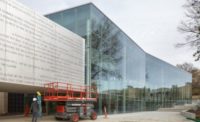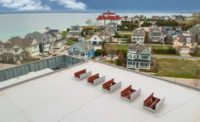Excellence in Design New Construction Educational Winner
The Center of Attention
A new student services center at a prominent university in Boston provides students with a chance to learn and play outside the box.

The Center for Career Development and Educational Resource Center is one of the many student amenities located in the building. PHOTOS BY BY RICHARD MANDELKORN

The center is located in the middle of many diverse, connecting neighborhoods with notable views of Boston. PHOTOS BY BY RICHARD MANDELKORN

The airy, two-story dining hall has become a new social center and popular dining spot on campus. PHOTOS BY BY RICHARD MANDELKORN

The exterior of the building balances the history of the area with the efficient features to illustrate a message of sustainability to the community. PHOTOS BY BY RICHARD MANDELKORN




| Boston University Center for Student Services |
| Submitted by: Bruner Cott (www.brunercott.com) |
| Date Completed: June 2012 |
| Size: 122,000 square feet |
| Location: Boston |
| Cost: $48 million |
| Certifications/Awards: LEED Gold Registered |
The LEED Gold certified Center for Student Services is Boston University’s (BU) new gateway to campus student life and services as well as the winner of EDC’s Excellence in Design Award for Educational New Construction. The building reflects the university’s commitment to provide students with comprehensive and seamless services in an environment that supports a mission of learning and creative development outside the classroom.
Located in Boston’s urban Kenmore Square, the 122,000-square-foot center anchors a prominent corner in Back Bay, carefully balancing the historic, 19th-century residential character of Bay State Road with the commercial and institutional context of Commonwealth Avenue. The building creates a visible street presence—under one roof—for four floors of student academic services: the Center for Writing, Academic and Pre-Professional Advising, student programs and leadership, the Center for Career Development and the Educational Resource Center, and a campus dining facility, all together with offices and meeting rooms, lounges, and other related community spaces.
The building is the outcome of an invited design competition and was completed in June 2012. The university sought creative approaches to developing a center that integrated services and social activities, and established a new institutional presence on campus and in the community. The interiors feature plenty of daylight and brightly colored tiles and furnishings. Large windows offer notable views of the city. The dining floors are designed to offer flexible space for large gatherings and public events, as well as intimate nooks and balconies for small groups and quiet study time.
|
Project Team
|
The airy, two-story, 1,100-seat dining hall has quickly become a new social center and popular dining spot on campus. Dining services include three floors, 11 different food stations including wood-fired pizza, tandoor cuisine and a dedicated gluten-free station. All food is prepared openly, with daily specials advertised on digital displays. A separate late-night dining venue and bakery on the basement floor is open to the public, connecting the campus to the community and its diverse surroundings.
Another fact about the dining component of this building is that it has been given a four-star rating from the Green Restaurant Association, and at the moment is the only university in the country with a four-star Green Certified Restaurant. To qualify for certification, applicants must get at least 100 points across seven environmental standards: water efficiency, waste reduction and recycling, sustainable furnishings and building materials, sustainable food, energy, disposables, and chemical and pollution reduction. They also must have a full-scale recycling program and swear off Styrofoam; this is all accomplished here. The kitchens are outfitted with ENERGY STAR appliances, water-efficient dishwashers and sink fixtures, and a state-of-the-art food pulper that collects scraps, centrifuges out wastewater and deposits the remaining compost for later recovery.
The building is also home to an extensive green roof which sits atop the area known as the Ellipse and is on an adjacent rectangular section on the second floor. Spanning nearly 6,000 square feet, the roof is on its way to becoming a lush, multicolor bed of vegetation that will also decrease the building’s carbon footprint.
“The challenge to create a building design that would integrate the necessities of large scale—a large dining area coupled with major student learning and career development services—was tremendously exciting to us,” says Leland Cott, FAIA, LEED AP, principal at Bruner/Cott. “The Dean of Students’ notion was that ‘a student should arrive with a question, leave with a plan and.... while in the building have a meal’ which created the conceptual armature upon which we eventually framed our design. This was a design challenge that really appeals to us!”
| Materials |
|
Flooring: Terrazzo: DePaoli Mosaic Company Carpets: Atlas; Karastan; Milliken; Bentley Prince Street; Shaw Floors |
|
Ceiling: Tiles: Armstrong |
|
Wood: Cabinets: Iaccarino & Son with Griffin Casework: Iaccarino & Son with Griffin; BDI |
|
Roofing: Green Roof: Sika Sarnafil |
|
HVAC System and Appliances: Kitchen equipment: Ovens: Revent Ranges: Jade Range Fryers: Pitco Hoods: Halton Waste Disposal: Somat |
|
Interior Finishes and Furnishings: Cafeteria furniture: Neudorfer Tables; Campus Air Classroom and Lounge furniture: Knoll; Steelcase; Herman Miller; Keilhauer; Davis; HBF; Allermuir; Crassevig |
|
Paints and Wall Coverings: Benjamin Moore; Sherwin Williams |
|
Energy Efficiency: Environmental controls: Schneider Electric Indoor lighting: Lightolier; Custom Metalcraft; Translite Systems |
|
Building Envelope: Brick and Masonry: Watsontown; Belden |
|
Plumbing Fixtures: American Standard; Sloan; Bobrick |
|
Other: Accent tiles: Nemo; Crossville; Oceanside Glasstile; Daltile Elevators: Otis Windows: Kawneer Card system: Orion Entrance Control |
Tremendous action was taken to help inform the students and faculty of the new elements in green at BU’s Student Services Center. The sustainable materials, finishes and systems were shared during working design charettes with faculty and staff. “During and post-construction, we gave guided tours to the occupants and participated in videos created about the building that were posted on the university’s website,” says Susan Morgan, AIA, project architect.
Peter Ziegler, AIA, project manager, says the university’s Director of Sustainability Dennis Carlberg has a very active outreach program, including a website and monthly online newsletter he uses to publicize matters of university-wide interest. “During design, and especially during construction, we worked with him on articles about energy efficiency, composting, greens roofs and more to help tell the story of the building while it was being built. We held a series of student focus groups to discuss a broad range of topics, including sustainability and other student-focused parts of the building,” says Ziegler.
Additional sustainable strategies employed for the project include:
- High-performance building envelope with double-insulated walls, spray foam insulation between studs and mineral wool outside of studs
- Daylighting and occupancy controls, high-efficiency lighting (primarily LED)
- Low-flow plumbing and kitchen fixtures
- Consolidated refrigeration system
- Groundwater and stormwater retention system
- Bicycle parking and storage
- Recycling and composting program throughout building
- Low-emitting materials and finishes
- Green cleaning measures
- The building replaces a former asphalt parking lot
Experiencing the world beyond and learning outside the classroom are essential parts of nurturing the development process of today’s students, who need a roadmap for this part of their journey. BU developed a strategy to aggregate student services under one roof to offer its undergraduate students an easily accessible and comprehensive environment to achieve this. Simultaneously, the building hosts a major, sustainably designed dining venue with extended hours allowing students to maximize their time in the building—studying, planning, working, socializing, and forming lifelong friendships—a cool place to see and be seen.
“The building, at the eastern edge of the campus, was intended to act as a gateway of sorts along the long axis of the campus,” says Cott. “The building has one foot in the 19th century and the other in the 21st century.”
Educational New Construction Honorable Mentions
|
Algonquin Centre for Construction Excellence Submitted By: Diamond Schmitt Architects Size: Diamond Schmitt Architects Location: Ottawa, Ontario |
 The LEED Platinum certified Algonquin Centre for Construction Excellence (ACCE) is a hybrid facility combining construction trades and technical design programs under one roof. A public corridor puts the school’s activities on full view and offers exhibits on sustainable design and real-time monitoring of the building’s systems. Fifty-seven percent of the roof is planted using native and adapted landscaping with self-irrigating felts reducing stormwater runoff. A 66,000-gallon cistern connected to the roof drains captures rainwater for reuse resulting in a 56 percent reduction in potable water use. Windows are placed to optimize daylight and energy with minimal glazing to control envelope losses. Other energy reduction strategies include a hydronic heat pump system, a decoupled ventilation system, radiant heating, solar thermal energy and more. These strategies result in 71 percent less energy use in operation as compared to the Model National Energy Code for Buildings. Each element was designed to enrich student experience and enhance bio-diversity throughout the center. The LEED Platinum certified Algonquin Centre for Construction Excellence (ACCE) is a hybrid facility combining construction trades and technical design programs under one roof. A public corridor puts the school’s activities on full view and offers exhibits on sustainable design and real-time monitoring of the building’s systems. Fifty-seven percent of the roof is planted using native and adapted landscaping with self-irrigating felts reducing stormwater runoff. A 66,000-gallon cistern connected to the roof drains captures rainwater for reuse resulting in a 56 percent reduction in potable water use. Windows are placed to optimize daylight and energy with minimal glazing to control envelope losses. Other energy reduction strategies include a hydronic heat pump system, a decoupled ventilation system, radiant heating, solar thermal energy and more. These strategies result in 71 percent less energy use in operation as compared to the Model National Energy Code for Buildings. Each element was designed to enrich student experience and enhance bio-diversity throughout the center.Photo by Tom Arban |
|
North Education Center Submitted By: DIRTT Environmental Solutions Size: 157, 521 square feet Location: New Hope, Minn. |
 North Education Center (NEC) is proof green buildings can excel environmentally and socially without costing more. Using 63 percent less energy than a building built to code, the total price for the three-story structure was $181 per square foot. NEC’s programming offers specialized education services for learners: gifted and talented, special education, alternative education, career training and staff and curriculum development. Ninety percent of the former building was recycled and used in the construction of the new building. Sustainable design features include sunshade devices to minimize direct sunlight and maximize daylight; a white membrane roofing material to minimize the heat island effect; special glazing on the upper section of the windows to disperse sunlight and minimize glare; light sensors and controls that dim lights as natural light levels rise. Low VOC and easy-to-maintain materials support student health, as well as a green cleaning program including a no-detergent ionized water system. Flexibility was a key consideration in the building design as the student needs can vary requiring changes in room size and configuration, resulting in the addition of an agile wall system for classrooms and support spaces. Casework and wall-mounted furniture systems are modular and can be reconfigured right along with the other systems. NEC reinvents education for students with challenges and is designed to support the behavior and learning of all students and provide a positive work environment for staff. North Education Center (NEC) is proof green buildings can excel environmentally and socially without costing more. Using 63 percent less energy than a building built to code, the total price for the three-story structure was $181 per square foot. NEC’s programming offers specialized education services for learners: gifted and talented, special education, alternative education, career training and staff and curriculum development. Ninety percent of the former building was recycled and used in the construction of the new building. Sustainable design features include sunshade devices to minimize direct sunlight and maximize daylight; a white membrane roofing material to minimize the heat island effect; special glazing on the upper section of the windows to disperse sunlight and minimize glare; light sensors and controls that dim lights as natural light levels rise. Low VOC and easy-to-maintain materials support student health, as well as a green cleaning program including a no-detergent ionized water system. Flexibility was a key consideration in the building design as the student needs can vary requiring changes in room size and configuration, resulting in the addition of an agile wall system for classrooms and support spaces. Casework and wall-mounted furniture systems are modular and can be reconfigured right along with the other systems. NEC reinvents education for students with challenges and is designed to support the behavior and learning of all students and provide a positive work environment for staff.Photo by TSP, Inc by Rick Peters, InsideOut Studios |
Looking for a reprint of this article?
From high-res PDFs to custom plaques, order your copy today!










